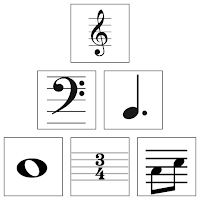Building Blocks: The Major Scale
The major scale is a group of 7 notes starting on a tonic when listed in ascending order. The tonic is the note that the scale is named by. For example:
The D Major scale starts on the note "D". D is the tonic of the D Major scale.
The F Major scale starts on the note "F". F is the tonic of the F Major scale.
The thing that distinguishes a major scale as "major" and not some other scale is the specific distances between every note in the scale. This is where knowing the difference between half-steps and whole-steps is important. There is a specific pattern of half and whole-steps starting from the tonic that makes it a major scale, which is:
W W H W W W H (W = whole-step, H = half-step)
I previously mentioned that sometimes you'll see half and whole-steps written as "semitone" and "tone", so you may also see it listed in some places like this:
T T S T T T S (T = tone, S = semitone)
This means that there is a whole-step between the first and second notes in the major scale, then another whole-step between the second and third notes, followed by a half-step between the third and fourth notes, etc. Just like remembering the two half-steps in the musical alphabet, it is easy to memorize where the half-steps are in the major scale because there are only two of them. They are always between the third and fourth notes, and the seventh and eighth notes in the major scale.
"8 notes? I thought you said there were only 7?!"
The 8th note is the same as the first note. Remember the musical alphabet only has 7 letters:
A B C D E F G
then the letters repeat:
A B C D E F G A B C D E...
so if you count 7 letters, the next letter will always be the same as the first letter.
We can build a major scale starting from any note we want, however there is one major scale that happens to use the exact same notes as the musical alphabet, and it is the only major scale that does. That is the C Major scale.
According to what we've learned so far, we know that the tonic of the C Major scale is "C". We also just learned that the C Major scale uses exactly the same notes as the musical alphabet, so it is:
C D E F G A B C
Let's check to make sure this follows the pattern of half and whole-steps we just learned. Remember the half-steps in the musical alphabet are between B and C, and E and F, and the rest are whole-steps. So, looking at the musical alphabet starting from C:
We can see that the half-steps are between the third and fourth notes, and between the seventh and eighth notes. Remember, the half and whole-step pattern for the major scale is W W H W W W H, so this checks out, but let's check this further just to be sure:
C to D is a whole-step (W) since there is a black key between them
D to E is another whole-step (W)
E to F is a half-step (H) since there is no black key between them
F to G is a whole-step (W)
G to A is a whole-step (W)
A to B is a whole-step (W)
B to C is a half-step (H)
This gives us W W H W W W H, which is the correct pattern, because the half-steps are between the third and fourth notes, and between the seventh and eighth notes, the way every major scale is supposed to be. Because the C Major scale happens to use the exact notes of the musical alphabet, and also because of where the half-steps are in the musical alphabet, starting a major scale on C will automatically put the half-steps between the third and fourth, and seventh and eighth notes.
Some things to consider going forward:
- Each major scale is unique and therefore no two major scales have the exact same notes
- Each major scale has one and only one of each letter name, except for sometimes repeating the tonic at the "top"
- All major scales follow the same half and whole-step pattern
We have learned to find the C Major scale as well as what distinguishes a major scale as "major". We don't quite have enough information to find the other major scales yet. In order to do that, we first need to learn about the Chromatic Scale, a scale that contains all the notes that exist in the western system of music. That is what will be covered in the next lesson.
< Sharps, Flats, and Accidentals
Please leave a comment if you have any questions!


Comments
Post a Comment
Feel free to ask questions or start a discussion, or leave a suggestion for future articles! Please keep it civil.